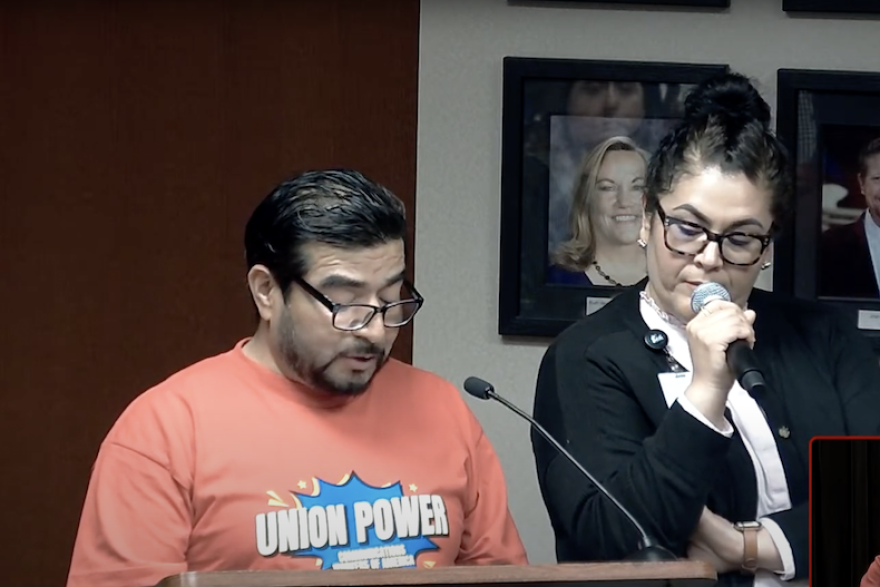A collection of hourly school employees in the Olathe school district are planning to unionize.
The group includes paraeducators, custodians, school nutrition workers, language aids and other members of the classified staff workforce at Olathe Public Schools who are paid an hourly wage.
In all, there are roughly 1,800 employees across the district who make up that workforce.
Many members of the Olathe schools unionizing effort came to the March school board meeting, donning brightly-colored shirts with the words “Union Power” written in big block letters across the chest.
More than half a dozen spoke during the public comment section of the meeting — some with an interpreter by their side — to explain why they’ve started the effort toward unionization. (Watch here, starting at 1:21:00).
Mario Ibarra, who has worked for the Olathe school district for more than 15 years as part of the school grounds maintenance division, said through a Spanish language interpreter that hourly school district employees need better salaries and access to better benefits.
“We are not getting enough to bring food to our families,” he said, adding that he works two jobs and has struggled with medical bills. “When we are united, we can create a change. I think we can fight together so the Olathe school district gives more resources for our salaries.”
Licensed and certified staff, including teachers, in the Olathe school district are already unionized under the Olathe chapter of the National Education Association, or ONEA.
Hourly Olathe school workers want better pay and benefits
The classified staff members who are part of the push to unionize are organizing under the CWA Local 6400, based in Lawrence. Classified staff in Lawrence Public Schools started organizing under that union local back in 2020.
A petition for Kansas School Workers United on the union’s website asks for a $20 minimum wage for all hourly school workers, as well as health insurance and retirement benefits that are “fully paid.”
The petition also calls on the state to provide more funding for schools, which CWA Local 6400 President Hannah Allison-Natale says will require some lobbying at the state level and teamwork among education professionals of all kinds.

Amber Grant, a paraeducator at Olathe South High School who spoke during the school board meeting on March 5, joined the unionization drive in January.
She told the Post in a social media message that the effort to unionize hourly school workers started about six months ago.
Custodians from some Olathe Public Schools buildings were “talking about living wages and their options,” she said.
Over the last few months, the discussions spread “across multiple schools and many different types of employees.”
Grant said she joined because she trains paras who work at Olathe South with her and has watched many leave because of pay.
“I’m tired of losing great employees because they have to find higher paying jobs to support their family,” she said. “For the work we put in for our students on a daily basis, something needs to change!”
“I love my job and working with the students so I chose to help make that change,” she added.
So far, Grant said members of the group have had a couple of conversations with Olathe Superintendent Brent Yeager, which “were promising.”
Allison-Natale — who was a para in Lawrence schools — agreed, adding that Yeager “understands the need for public employees to unionize.”
Yeager, in a prepared statement emailed to the Post, said: “In Olathe Public Schools, we want all our staff members to feel heard and respected, and we respect their right to unionize. It is so important to me and all our district leaders that our staff members feel a sense of belonging in Olathe Public Schools every single day.”
Olathe schools are working on staff retention
One key part of the school district’s strategic plan priorities is to work on staff retention, something Yeager emphasized in his statement.
In particular, the plan calls on district staff to attract and keep skilled school staff of all types through “competitive compensation and benefits,” Yeager said. (Read that on pg. 5 of the district’s strategic plan.)
One of the major barriers, he said, is the underfunding of special education from both the state and federal governments.
Olathe schools has spent $100 million of its general fund over the last three years covering shortfalls in state funding for special education, money that could have been spent on staff retention and other district priorities, he said.
Allison-Natale also sees school funding — an issue decided annually by the Kansas Legislature — as a barrier to being able to pay better wages to educational support staff.
“Our working conditions are students’ learning conditions, so it really makes a difference when we can fully support our classified staff,” she said. “It makes a difference in the lives of students.”
Olathe school custodians could unionize first
Though Allison-Natale said hundreds of classified staff members in the Olathe school district have signed the petition, the custodians may be the first to formally join the CWA Local 6400 because the majority of those workers have signed the petition already.
Then, the union will look to expand to include other classified staff, like paras, food service employees, grounds maintenance crews and administrative assistants.
Back when hourly workers in the Lawrence school district started unionizing four years ago, they also went division by division.
“Eventually every group was covered by the union contract,” Allison-Natale said.
What comes next?
Right now, the Olathe hourly workers unionization group needs more signatures on its petition.
At some point, under Kansas law, the Olathe school board will have to opt into the Kansas Public Employer-Employee Relations Act before a union can be recognized.
Additionally, Yeager said in his prepared statement that district administration will hold a series of roundtables with “specific departments and their leaders to listen and learn from our classified staff and to come away with actionable steps.”
This story was originally published by the Johnson County Post.





